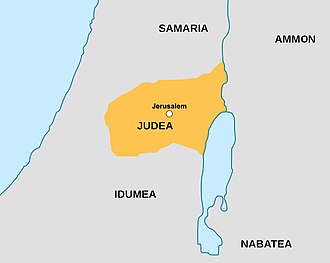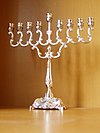Maccabean Revolt
This article's lead section does not adequately summarize key points of its contents. (October 2018) |
The Maccabean Revolt (Hebrew: מרד החשמונאים) was a Jewish rebellion, lasting from 167 to 160 BCE, led by the Maccabees against the Seleucid Empire and the Hellenistic influence on Jewish life.
Timeline[edit]
In the narrative of I Maccabees, after Antiochus IV issued his decrees forbidding Jewish religious practice, a rural Jewish priest from Modiin, Mattathias the Hasmonean, sparked the revolt against the Seleucid Empire by refusing to worship the Greek gods. Mattathias killed a Hellenistic Jew who had stepped forward to take Mattathias' place in sacrificing to an idol as well as the Greek officer who was sent to enforce the sacrifice. Afterwards, he and his five sons fled to the wilderness of Judah. After Mattathias' death about one year later in 166 BCE, his son Judah Maccabee led an army of Jewish dissidents to victory over the Seleucid dynasty in guerrilla warfare, which at first was directed against Hellenized Jews, of whom there were many. The Maccabees destroyed Greek altars in the villages, circumcised boys and forced Hellenized Jews into outlawry.[2] Judah's nickname "Maccabbeus," now used in popular culture to describe the Jewish partisans as a whole, is taken from the Hebrew word for "hammer".[3]
The revolt itself involved many battles, in which the Maccabean forces gained notoriety for their use of guerrilla tactics and their speed and mobility, in contrast to the slow and bulky Seleucid army. After the victory, the Maccabees entered Jerusalem in triumph and ritually cleansed the Temple, reestablishing traditional Jewish worship there and installing Jonathan Apphus, Judah's youngest brother, as high priest. A large Seleucid army was sent to quash the revolt, but returned to Syria on the death of Antiochus IV. Beforehand, Judas Maccabbeus made an agreement with Rome and became allied, tying the hands of the weaker Seleucid Empire. Its commander Lysias, preoccupied with internal Seleucid affairs, agreed to a political compromise that restored religious freedom. [4]

- Battle of Wadi Haramia (167 BCE)
- Battle of Beth Horon (166 BCE)
- Battle of Emmaus (166 BCE)
- Battle of Beth Zur (164 BCE)
- Battle of Beth Zechariah (162 BCE)
- Battle of Adasa (161 BCE)
- Battle of Elasa (160 BCE)
Studies[edit]
In the First and Second Books of the Maccabees, the Maccabean Revolt is described as a response to cultural oppression and national resistance to a foreign power. Modern scholars, however, argue that the king intervened in a civil war between traditionalist Jews in the countryside and Hellenized Jews in Jerusalem.[5][6][7] As Joseph P. Schultz puts it:
"Modern scholarship ... considers the Maccabean revolt less as an uprising against foreign oppression than as a civil war between the orthodox and reformist parties in the Jewish camp."[8]
Professor John Ma of Columbia University argues that the main sources indicate that the loss of religious and civil rights by the Jews in 168 BCE was not the result of religious persecution but rather an administrative punishment by the Seleucid Empire in the aftermath of local unrest, and that the Temple was restored upon petition by the High Priest Menelaus, not liberated and rededicated by the Maccabees.[9] Sylvie Honigman of Tel Aviv University advances similar arguments.[10]
Aftermath[edit]
All five sons of Matthias died violent deaths: Judas and Eleazar died in battle, Jonathan was betrayed and killed by the Seleucid general Tryphon, Simon was killed at a feast in Jericho by his son-in-law Ptolemy and John Gaddi was seized and killed by the sons of Jambri from Medeba.
After the success of the Maccabean Revolt, kings of the Hasmonean dynasty continued their conquest to the surrounding areas of Judea. Those who remained of the Jewish party favoring Hellenistic influence, forced to submit to Mosaic Law, repeatedly called upon the Seleucid Empire for assistance. At the time, however, the Seleucid Empire was weakened by political infighting and other wars, including against Ptolemaic Egypt, reducing their ability to reconquer Judea. In one particular instance, however, Jonathan Apphus (son of Mattathias) was convinced by Tryphon to dismiss 40,000 of his men and meet him for a "conference", which turned to be a trap. Jonathan was captured and later executed, against a deal Tryphon had made with Jonathan's brother Simon for Jonathan's liberation, in exchange for one hundred talents and Jonathan's two sons as hostages. Simeon was later murdered by his son-in-law, Ptolemy son of Abubus. Afterwards, Simon's third son, John Hyrcanus, became ruler and High Priest of Israel.[4]
Legacy[edit]
The Jewish festival of Hanukkah celebrates the re-dedication of the Temple following Judah Maccabee's victory over the Seleucids. According to Rabbinic tradition, the victorious Maccabees could only find a small jug of oil that had remained pure and uncontaminated by virtue of a seal, and although it only contained enough oil to sustain the Menorah for one day, it miraculously lasted for eight days, by which time further oil could be procured.[11]
See also[edit]
References[edit]
- ^ Maccabees at Encyclopædia Britannica
- ^ Nicholas de Lange (ed.), The Illustrated History of the Jewish People, London, Aurum Press, 1997, ISBN 1-85410-530-2
- ^ The Maccabees/Hasmoneans: History & Overview (166–129 BC) Jewish Virtual Library
- ^ a b Schurer, Emil (1891). A History of the Jewish People in the Times of Jesus Christ. 1. Hendrickson Publishers. ISBN 1565630491.
- ^ Telushkin, Joseph (26 April 1991). Jewish Literacy: The Most Important Things to Know about the Jewish Religion, Its People, and Its History. W. Morrow. p. 114. ISBN 0-688-08506-7.
- ^ Johnston, Sarah Iles (2004). Religions of the Ancient World: A Guide. Harvard University Press. p. 186. ISBN 0-674-01517-7.
- ^ Greenberg, Irving (1993). The Jewish Way: Living the Holidays. Simon & Schuster. p. 29. ISBN 0-671-87303-2.
- ^ Schultz, Joseph P. (1981). Judaism and the Gentile Faiths: Comparative Studies in Religion. Fairleigh Dickinson Univ Press. p. 155. ISBN 0-8386-1707-7.
- ^ Ma, John. "Re-examining Hanukkah", The Marginalia Review of the Book, July 9, 2013
- ^ Linda Zollschan, "Review of Sylvie Honigman, 'Tales of High Priests and Taxes'", in Bryn Mawr Classical Review, 2015.08.07
- ^ Talmud, Tractate Shabbat
External links[edit]
| Wikimedia Commons has media related to Maccabean Revolt. |
- Maccabean Revolt at Oxford Bibliographies
- Maccabean Revolt at the Aish HaTorah website
- Book XII of the Antiquities of the Jews
- Book I of The Jewish War


